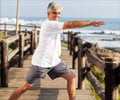Brief bursts of intense exercise before meals helps control blood sugar in people with insulin resistance more effectively than one daily 30-minute moderate exercise session.

The participants completed three separate exercise interventions in randomised order. Measures were recorded across 3 days with exercise performed on the middle day, as either: (1) traditional continuous exercise (CONT), comprising one 30 min moderate-intensity (60% of maximal heart rate) session of incline walking before dinner (evening meal) only; (2) exercise snacking (ES), consisting of 6×1 min intense (90% maximal heart rate) incline walking intervals finishing 30 min before breakfast, lunch and dinner, with one minute slow walking recovery time after each minute of intense exercise; or composite exercise snacking (CES), encompassing 6×1 min intervals alternating between walking and resistance-based exercise (with a one-minute slow walking recovery minute after each minute of exercise), again finishing 30 min before breakfast lunch and dinner. ES and CONT were matched for energy usage, whereas ES and CES were matched for time but CES provided a brief workout for all of the body's major muscle groups across the day. Meal timing and composition were the same for all three exercise interventions, and monitored using diet records, daily verbal discussion, and dietary analysis software.
Female participants completed the trials in the early follicular phase of their menstrual cycle (across three separate cycles), whereas male participants had a minimum of 7 days between trials.
The researchers found that the ES and CES routines controlled blood sugar more effectively than the CONT routine, particularly 3-h post-meal glucose following breakfast (17% reduction compared to no exercise) and dinner (13% reduction compared to CONT). Across the day this represented a 12% reduction in mean post-meal blood glucose concentration. The effect of the pre-lunch ES on blood glucose levels after lunch was unclear. Moreover, the reductions in blood glucose with ES compared to CONT persisted for a further 24 hours across the day following exercise.
While acknowledging that further work is required to determine the clinical significance of their study, the authors say their work adds to the recent interest in 'accumulating physical activity' as brief, repetitive bouts of intense exercise (as opposed to a single, prolonged, continuous exercise session) to prevent cardiometabolic disease. Many international guidelines prescribe exercise to maintain health (for example 30 min of moderate exercise 5 times a week), but such regimes still leave many people with prolonged sedentary time or inactivity, which has already been highlighted in previous research as harmful to health. Previous research has also shown more frequent breaks in sedentary time are beneficial for waist circumference, blood glucose control and other metabolic parameters.
Exercise 'snacking', whether before meals or not, provides breaks in sedentary time, and thus may be important for public health. In this study, 30 min of moderate-intensity exercise (CONT) did not improve blood sugar control, whereas distributing the same volume of exercise as three brief pre-meal HIT 'exercise snacks' resulted in a mean 12% reduction in the average post-meal glucose level (the mean across the three meals), an effect that was also sustained across the subsequent day. Walking-based (ES) and combined-exercise (CES) snacks improved blood sugar control similarly, and both forms of exercise involved similar levels of exertion in the nine patients. In this study ES lowered 24-h glucose levels relative to the control day, whereas CONT did not. Although compared to the control day ES was more effective than CONT on the day after exercise (subsequent 24 h), on that day the 24-h mean glucose for ES was not statistically significantly lower than CONT.
Advertisement
"The notion of doing small amounts of interval exercise before meals is a unique and very important feature of this study," says Francois. "Sustained hyperglycaemia following meals is an important feature of insulin resistance. Reducing these post-meal spikes is important for reducing the risk of developing type 2 diabetes and its associated complications."
Advertisement
She concludes: "We found exercise snacking to be a novel and effective approach to improve blood sugar control in individuals with insulin resistance. Brief, intense interval exercise bouts undertaken immediately before breakfast, lunch and dinner had a greater impact on post-meal and subsequent 24 h glucose concentrations than did a single bout of moderate, continuous exercise undertaken before an evening meal. The practical implications of our findings are that, for individuals who are insulin resistant and who experience marked post-meal increases in blood glucose, both the timing and the intensity of exercise should be considered for optimising glucose control."
The researchers are continuing the work in this area, and are set to publish further studies, including one other acute 24 hour response to high-intensity exercise using different forms of exercise in younger sedentary individuals, and a longer-term training study on other health-related measures. They also plan to study such exercise targeting younger insulin-resistant individuals.
Source-Eurekalert















